
Graham Noble provided the following articles. People with additional
information are asked to send it to the editor at jrsvinth@juno.com.
Copyright © 2000. All rights reserved.
"The La Savat Championships," Health & Strength, March
1903, page 104.
Dear Sir, -- I wish to let you know that I did not go to Paris for the "Championnats de Boxe." A month ago I wrote to the French paper, Le Vélo, that I would be pleased to participate in the event if the two champions, Charlemont and Casteres, were participating too. But these two professors, who I have long wished to meet, did not participate. They are to have a match together to-morrow, February 21st. In another way the regulations of the Championnat are quite different to my method, which is as an English contest. I like to fight to win, and not to box as an exercise.
I am at the disposal of the winner of the Championnats de Boxe, and also at the disposal of the winner of the match, Charlemont-Casteres, for a match under the Queensberry Rules, and for any stake they want.
Yours very truly.
(Prof.) Pierre Vigny
New School of Self-Defence and Fencing Academy
18, Berner's Street, W.
20th February, 1903

***
"Editorial Notes," Health and Strength, April 1903, pages 109-110.
The frontispiece to this issue shows Prof. Pierre Vigny and his assistant, Miss Sanderson, in two poses in the new art of self-defence with a walking-stick, as originated by Prof. Vigny. The latter is director and manager of the New School of Self-Defence and Fencing Academy, at 18, Berners Street, W., where pupils are taught the art of defending themselves unarmed in the street, in a dozen lessons. This system combines boxing, la savat, fencing, walking-stick, with tricks and counters in wrestling. Prof. Vigny is desirous of meeting the French la savat champion -- I am not sure at time of writing whether Charlemont or Casteres hold this title -- and it should make a good match for the National Sporting Club.
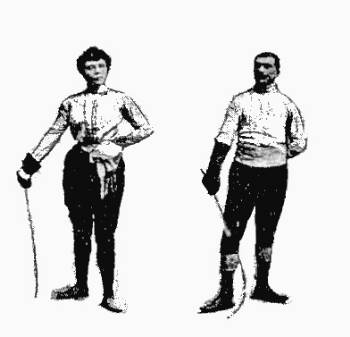
"The Walking-Stick as a Means of Self-Defence," by Pierre Vigny, Health and Strength, July 1903, pages 253-254.
The fashion in walking-sticks is to have a silver-mounted Malacca cane; everyone uses one. Everyone knows that in choosing a Malacca, it will not only serve the purpose of something to carry in one's hand, but that this beautiful cane, the most up-to-date of all sticks, can render great service as a means of self-defence, for it can become a formidable weapon in the hands of those who have learnt how to use it.
Stick exercise falls essentially under the head of gymnastics, but if it develops muscular strength it must also be borne in mind that it renders limbs supple and gives everyone agility, elegance and grace in their movement. Moreover, referring to my long experience as a professor of physical exercise specially adapted to self-defence, I can confidently assert that the cane is the most perfect weapon of defence, as with it no one can be handicapped by size, weight, or strength, it equalises the chances of two people each armed with sticks.
Boxing is, without doubt -- and I say so most emphatically -- an exercise the health-giving advantages of which cannot be too strongly made known. It gives quickness, suppleness, strength and endurance, without the aid of any developing machine, and also makes a man have confidence in himself, thus enabling him to face danger fearlessly. Here, then, I have stated some of its real advantages, but we must admit that they would lose some of their value if one were to encounter a bigger and stronger adversary. Smartness and quickness I admit can often take the place of size and strength, but it must also be admitted that the length of arms, legs, weight and strength, give on their side material advantages more efficacious and of a great importance. Therefore, from the above facts, it must be admitted that a smaller and weaker man, whatever be his relative cleverness and strength, will nearly always be held in check by a bigger and stronger man, should he be even less clever and quick.
With the cane all inferiority disappears, and I assert most emphatically from my long and practical experience that a man armed with a cane, and who has learnt how to use it, does not fear a bigger and stronger man, though similarly armed. I will say even more: if he perfectly understands how to use his stick as a weapon of defence, he can hold his own against several adversaries for whoever is hit by this weapon, which acquires an enormous force in its swinging motions, does not return to the attack again, therefore the cane is the most perfect weapon for self-defence; but in order to make it so, it must possess the necessary qualities, which, expressed in one word, is solidity.
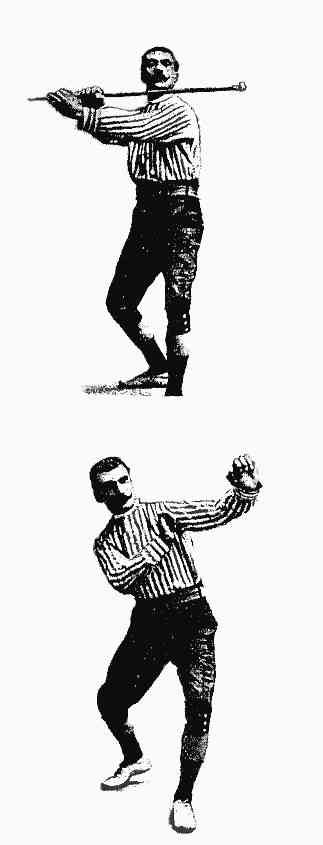
It is for this reason that I have had a cane specially made under my directions which embraces all the necessary qualities. It is a medium-sized Malacca cane, mounted with a thick metal ball, and so firmly riveted to the cane that it cannot come off however roughly it may be used. The metal ball handle is of such a thickness that it will not get dented; but in spite of this the cane is a most handsome and elegant one, and has been so much appreciated since it has been brought out that many people may be seen carrying them. Everyone soon gets to understand that this beautiful cane is in reality the most perfect weapon of defence, which entirely relieves one of the danger of carrying a revolver, and the feeling of disgust of having a dagger about one.
It is hardly necessary to add that as one learns the use of a sword or foil, so one most certainly should learn how to use a stick, which under my system of instruction can be learnt in twelve lessons. The study of my system of self-defence with the cane does not involve hard and irksome work; people take a great pleasure and interest in it from the very first lesson, and thus they also acquire quickness, suppleness, coolness and self-confidence.
There are various ways of using the stick:
1st -- Holding the stick by the grip of the whole hand, the blow is delivered with a swinging hit.
2nd -- The left hand can be used just as well as the right by alternately passing the stick from one hand to the other.
3rd -- The stick may also be held at the ferrule end.
4th -- The stick may also be held in both hands.
The blows are delivered at the head, face, body, on the hands, and at the legs. To deliver a point, the stick is made to glide through the hands. The end of the stick can also be used as a dagger.
For a blow to be effective, you must strike, whilst avoiding the riposte and the contact of the sticks, for if your stick comes into contact with your opponent's stick before striking him, the blow is rendered useless, having lost all its force.
If one is struck, one should return on guard and not try to give another blow. It is allowed to seize your adversary's stick, this being really an excellent thing to do.
Using the stick as a means of self-defence in the street, one can not
only fight one man equally well armed, but also several men at the same
time equally well armed as one's self, for the stick is made to pass through
every possible direction around you with a marvellous rapidity, thus protecting
every part of one's body; and at the same time acquires enormous force
by its rapid swinging movements for delivering a blow, which no one can
possibly stand against.
"All-round Self-defence," by Captain H. Webb, Health and Strength, December 1903, 433-434.
"With the present reign of Hooligan terrorism, [EN1] the noble art of self-defence needs more and more the addition of new methods. The best means of thoroughly mastering this necessary art is to practise its basis, i.e., English boxing, which does more to make a real athlete than any other branch of Physical Culture.
To this science should certainly be added knowledge of Japanese wrestling [e.g., judo], and also of La Savate. I do not mean by this that one should learn all the Savate blows, a few only are sufficient, the most useful being the direct kick from the front, le coup de pied brise, le coup de bas de jambe, and the Chasse-bas. Here, then, we have practically the complete art of self-defence, using only the arms with which nature has provided us.


Certainly it does not appear at first an easy task to master, but really nothing is more simple and interesting. Remember there exists a method -- nothing if not practical -- embracing the several styles enumerated above. This method is that of the well-known Professor Pierre Vigny, of 18, Berners Street, who has devoted twenty years to the study of self-defence in all its various forms.
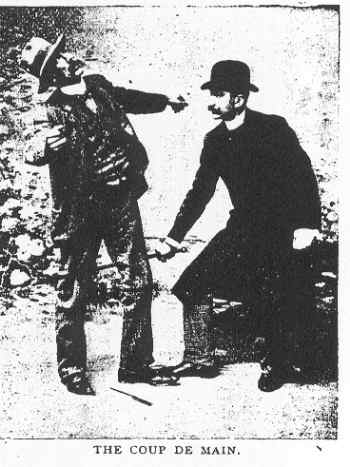
It is indeed quite easy to find an excellent master, for the sword and boxing masters are legion. Professor Vigny's "new Art of Self-Defence" with the walking-stick or umbrella requires the same dexterity with the left hand as with the right, and is mostly done with the wrist, each blow being effective.
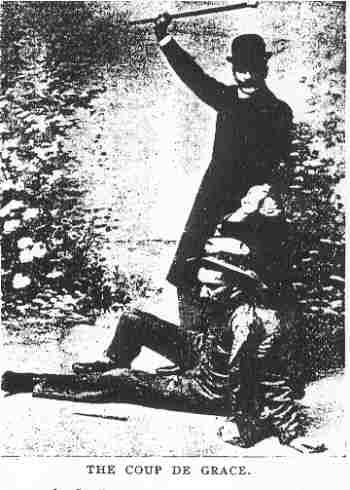
It may seem singular that an inoffensive walking-stick can become a terrible weapon and the most useful means of self-defence in the street, but nevertheless it is so. One lesson from the master Pierre Vigny will convince unbelievers as to the wonderful count a walking-stick may be put to. The Professor has already turned out a number of first-rate pupils, and has received a large correspondence from all parts of the world enquiring about his system of self-defence. The following is an interesting account from Sporting Life of a sketch given by Professor Vigny at the "Royal" [a music hall], entitled "Attacked by Hooligans": --
J. St. A. Jewell, "The Gymnasiums of London: Part X. -- Pierre Vigny's" Health and Strength, May 1904, pages 173-177.
Ask any man who speaks the English language what is the finest system of self-defence, and it's a hundred to one that he will clench his fists intuitively and answer with a grin, "Boxing, of course!" It's in the breed, and has been, from the time when our ancestors were barbarians of a crude order, and it will be for all time.
Ask a Frenchman the same question, and he will hesitate to reply. After consideration he may say, "La savate," but his tone will not indicate the conviction that the answer of the Britisher carries to the same question.
Ask the same question of an Italian, Greek, Portuguese, or South American, and it is ten thousand to one that he'll give preference to the knife. It's all a question of custom and tradition, and when attack comes, a man will resort to what he has been used to, whether it be a quick solid punch from the shoulder, a wicked full-forced kick, or a straight jab or sweeping slash with the knife.
Recognising the want of a system of all-round self-defence, many men have devoted years of study and practice to perfect one, and many who have worked their own pet methods out to nine places of decimals, so to speak, have found weak points when they have put it to the test. In some systems these weak points have remained unremedied for obvious reasons, and the men who have worked at them for years have thrown up the sponge in face of face of innumerable difficulties. These are the self-defence failures.
There are others, however, whose efforts have been crowned with brilliant success, and in whose methods have been incorporated moves for every known attack, except from firearms, and these are the men who are the self-defence successes. Among them stands out prominently the central figure of this article -- Pierre Vigny -- the man who has learned every system, and built one of his very own by taking everything that was good from each and moulding them into a complete whole.
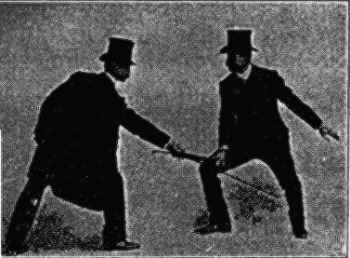
Boxing, French and English style; fencing, with sabre, duelling-sword, foil, or single stick; wrestling, any fashion; Jujitsu, fighting with any weapon from a knuckle-duster to a parasol -- he is at home in each.
Imagine a tall, upright figure, clad in a close-fitting white tunic, black silk knee breeches, stockings, and white canvas shoes, the figure of a spare-built man in the prime of life, with close-cropped hair, clean shaved, save for a dark moustache, full open eyes, and a jaw that betokens strong will. Put a smile on the face, a kindly twinkle in the eyes, and a silver-headed Malacca cane in the hands, and you have Pierre Vigny at his gymnasium in his favourite costume, about to take in hand one of his many pupils.
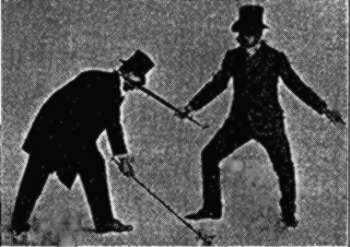
Pierre Vigny is French by birth and education, from the top of his head to the heels of his boots; yet he does not fulfil the popular conception of a son of La Belle France. To us, as a nation, the Frenchman is still as our traditions have made him -- a mercurial individual, fantastic of dress, with exaggerated mannerisms, full of emotion, a brilliant winner, but a poor loser, a man to whom success is absolutely essential to happiness, and who breaks down woefully when adversity falls to his portion. None of these traits fits the man whose pen portrait I am drawing now, for his manner is always quiet and subdued; he can hang on with bulldog tenacity in an uphill fight, and give and take with a cool head and an everlasting smile on his face.
To the English sportsman he endears himself immediately, for he loves the "noble art" for the sport of it alone, and although he has spent years at all other kinds of manly pastimes, the gloves hold first place in his affections.

Such is the man who presides over the artistically appointed School of Self-Defence and Fencing Academy, at 2, Hinde Street, Manchester Square, W. At the age of ten he had already acquired a very fair knowledge of la savate, fencing and English boxing, and eager to add to his knowledge, he passed from academy to academy, learning all he could at one, only to desert it for another when the full measure of instruction had been meted out to him.
Then he entered that stage of his career that marked him as an enthusiast, the stage wherein school practice was placed aside for brutal practical experience. Full of confidence in his own abilities as a self-defence man, he made nightly excursions into the roughest of the rough quarters of Paris, Lyons, Marseilles, Naples, Genoa, in the knowledge that he would soon have ample opportunities of pitting himself against men who robbed for a livelihood, would commit a brutal assault for five francs, and a murder for twenty.
Then in many a gambling hell and drinking den he stood back to the wall
and put into execution all those brilliant moves with which he now delights
many a fashionable London audience, and, as a proof that he was an apt
pupil of good instructors, he came away in every case without a scratch.
Of his many assailants, the least said the better.

In 1886 the military authorities called upon him to enter the Army, and he joined the Second Regiment of French Artillery at Grenoble, where he served with distinction as fencing master for three years. Leaving the Army in 1889, he opened a fencing academy at Geneva, and soon gathered together a large clientele. Here he set about perfecting his now famous system of self-defence with a walking-stick, which has completely mystified all the Continental and English experts.
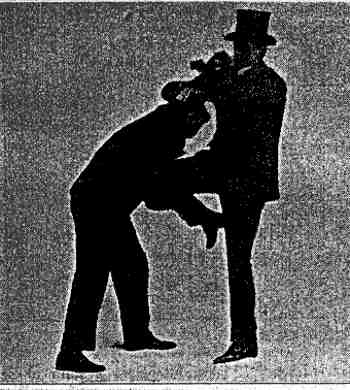
Geneva lost its charms for him after a time, in that it did not offer sufficient scope for his talents, and so it was that he came to England to learn anything and everything that the English could teach. For a time he was Chief Instructor at the Bartitsu School, at 67, Shaftesbury Avenue, where he was daily in company with the two famous Japanese Jujitsu men, [S. K.] Uyenishi and [Yukio] Tani. From them he added to his already large stock of self-defence knowledge, and that Mr. Barton-Wright judged his abilities of the highest order may be best proved by the fact that he (Mr. B. Wright) offered to back him against all comers on the condition that each man should be allowed to fight as he liked, using only his natural weapons.
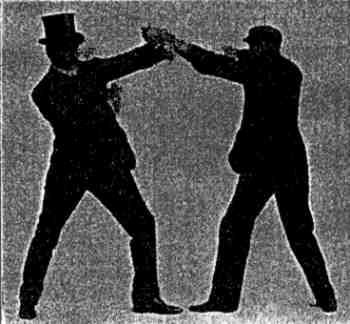
Pierre Vigny left the Bartitsu School to open one of his own, at 18, Berners Street, W., for he recognised that there was a great opening for a competent teacher of all-round self-defence in the metropolis. Pupils came in shoals, and the success of the School was assured. Morning, noon, and night the sizz of foil crossing foil, sword crossing sword, or the sharp, solid crack of stick against stick was heard, and as the popularity of the place grew, so did the list of pupils, until a time came when more commodious quarters became a necessity. Thus it came about that the School moved to its present address -- 2, Hinde Square, and when Pierre Vigny gave an all-round demonstration there to mark his official opening day, I had the honour and pleasure of introducing him to his audience.
First he gave a demonstration of fencing with the foils, his antagonist being the accomplished lady known to the public as Miss Sanderson, who, it may be remarked, is, in private life, Madame Vigny. Have you ever, by the bye, been a spectator at a fencing bout between two past masters in the art? In truth, it is a feast for the eyes, every rapid pass, every cunning feint, every skilful parry, appealing to that deep-down-at-heart admiration we all have for clever attack and defence in overwhelming fashion. First it is a simple quick thrust, which develops with lightning rapidity into a hard-pressed attack, met by cat-like retreat and bewildering stopping tactics, and a moment later the order is reversed and the attacker becomes the attacked, and is forced back step by step at the point of the metal button at the end of the weapon. It's nearly all wrist work, and one wonders how long flesh and blood can stand the strain.
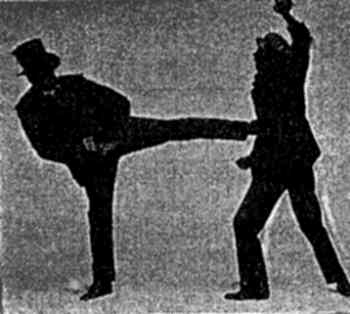
Beside the duelling-sword, however, the foil is as child's play, for the former is a weighty weapon that calls for great strength in handling.
Once more the two faced one another -- lady and gentleman, husband and wife -- the lady as much at home with the weapon as her husband. They went through the Grand Salute, that complicated but beautifully graceful ceremony that precedes a bout, each sweep, each curve, each gesture a complete poem in itself.
The gift of describing in detail beautiful motion and graceful poises is enjoyed by few, and I am not of the number. Had I the gift, I would paint you a word picture in which the predominant colour would be the shining blades of the two swords, and the centre of interest an intricate pass stopped by a delicate turn of the wrist no less wonderful. The gift, alas! is denied me, and never have I regretted so much as I do at this moment, when I would describe to you, if I could, a bout that was full of interest from the time the masks were donned until both fencers bowed their acknowledgments to the appreciative audience.
No sooner was the bout over than the tit-bit of the afternoon was submitted, in the shape of a demonstration of Pierre Vigny's system of self-defence with a walking-stick, given by himself and Miss Sanderson, and followed by a fierce bout between Vigny and his clever pupil, Mr. Roger Noel.
Walking-stick attack and defence is Vigny's pet creation, and to such a pitch of perfection has he brought it, that no one now disputes his claim to be the Champion Bratonniste of the World. First he showed how to keep a hostile mob at bay armed only with a silver-headed Malacca cane, and he revolved this weapon with such rapidity that at times the silver knob formed a complete and sustained shining circle round his head. Cut, thrust, swing, or jab, it was the same -- finished, complete and wonderful. Encircled by imaginary enemies, that fearful stick was here, there, and everywhere, and the man who handled it showed by the handling that not a single phase of Hooligan attack has been unprovided for.
Then Miss Sanderson came to the attack, and the demonstration showed her to be as capable with the stick as the sword. She passed it from hand to hand so quickly that the eye could scarcely follow the movements, and all the while her blows fell thick and fast. Down slashes, upper cuts, side swings, jabs and thrusts followed in quick succession, and the thought arose, how would a ruffian come off if he attacked this accomplished lady, supposing she had either walking-stick, umbrella, or parasol at the time? In tests, she has faced more than one Hooligan, who was paid to attack her, and each time he has earned his money well. Mr. Roger Noel proved a highly capable pupil of an accomplished master, and gave and took hard knocks that many a professional "bruiser" would shrink from.
Followed a bout of La Savate between Vigny and another pupil, a bout which fully demonstrated the possibilities of the French method. To the English eye, the kicks which are allowed in it might appear unsportsmanlike, but Vigny teaches it not as a sport, but as a means to stop brutal attack. One does not stop to consider matters of etiquette when the robber's hand grabs the gold watch and a confederate tries to garotte from behind. In such case, a straight punch on the "point," followed by a kick on the kneecap are fair means, and La Savate provides countless others moves just as efficacious.
The bout ended amid the clapping of hands and many expressions of admiration, and scarce had the noise ceased when Vigny gave a demonstration with another pupil of self-defence tactics for street-row use. Part was boxing, part wrestling, part Jujitsu, and part La Savate; but each move blended into the next like a piece of joiner's dovetailing. One led and landed short, and that proved his undoing, for the next instant he was bent double, rendered helpless, and his arm was by way of being twisted out of socket. That was boxing and Jujitsu. Then the pupil rushed, driving hard with his left, but Vigny ducked aside, pivoted on his left leg and kicked on the mark with his right, in a full body swing, following up the move with back-heeling his man. That was La Savate and wrestling.
After the performance was over, the little audience viewed the premises, praised the decorations, admired the sumptuous dressing-room, and looked admiringly at the rows of bright shining steel blades that adorned the walls, and left wondering.
When the waning light heralded the close of day I was left alone with the man who had provided the entertainment, and with him I discussed his hopes, ambitions, his methods.
"Boxing," he said, "is the finest self-defence in the world, but it is not enough. To be of value to a man in a street row, he must first be thoroughly competent, and also be able to stand punishment. Some men," he added, "cannot stand punishment, so that even if they could box, one solid punch -- enough to cause pain -- and they are done. Again, what if a boxer be attacked with a knife?"
I did not answer, so the Professor went on: "In my system, I do not care if one be attacked by belt, knife, or stick -- there are many moves for every attack known; a walking-stick, umbrella or parasol becomes a dangerous weapon, and a belt or knife is no match for a stick well handled."
"Will you give me proof of that?" I asked, and he smilingly answered, "Yes."
Thus it came about that I fought Pierre Vigny for the hard, cold proof, and I fought him as I have fought often before in parts of the world where a man's reputation is measured by the force of his blows, and the story of the fight shall remain untold, saving only this -- that, for his own peace of mind and my bodily comfort, he did not retaliate, but merely stopped my attacks, and incidentally, in all three bouts, I failed to touch him with either fist, knife, or stick.
What he showed me he is teaching every day from nine in the morning
until eight at night, and if he receives but one per cent. of the support
that he undoubtedly deserves, he will long continue to preside over the
School that he graces so well.
"Professor Pierre Vigny's Sixth Great Annual Tournament," Health and Strength, January 1906, pages 38-39.
This tournament, which took place on the 22nd of November last [year; e.g., 1905], was of very special and absorbing interest, on account of the numerous and varied discussions which have of late raged in the world of Athletics as to the disputed pre-eminence of the different systems of self-defence.
A large, enthusiastic, and aristocratic audience thronged the Steinway Hall, and to judge from their vociferous applause evidently felt themselves well repaid for their visit.
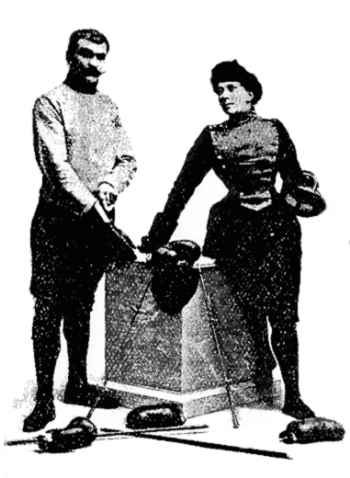
There were no less than thirteen items on the programme, representing in all every branch of physical antagonism. The great revival which has recently taken place in the use of the sword was abundantly evidenced by the brilliant displays given in the foil, epée, and sabre contests. These included the semi-final and final stages of an epée competition for amateurs for the prize of a silver cup, presented by M. Vigny. This was won eventually by M. Noel, after a very spirited bout with M. Wagenmann.
Foil play found admirable representation at the hands of Professor H. Uyttenhove, Assistant at Bertrand's Fencing Academy, and Professor Pontnau, at McPherson's Academy in Sloane Street, in which after a very brilliant bout, the victory went to the Belgian, H. Uyttenhove. This beautiful art was also the occasion of a most exciting and brilliant bout between Professor Fontaine, of the London Fencing Club, and Professor Crosnier, of the Sword Club, and which was gained by the latter. Foils in the Italian style, produced a very interesting display between Professor Magrini and Mr. R. Vinci, while the Sabre Contest between Professor Magrini and Staff-Sergt. W. Palmer was a most exciting contest between two brilliant opponents.
The English system of self-defence [boxing] found representation by Professor Arthur Westley, the well-known instructor, and Mr. F. Creasy, the winner of the Polytechnic 8-stone 8lbs. [120-pound] Club Championship.
With the modern enthusiasm for all things Japanese, it is scarcely necessary to state that the Ju-jutsu demonstration by Professor S. K. Uyenishi and his pupils aroused, as it always does, the very greatest interest. The little Professor, who was unfortunately suffering evidently from a few contusions, nevertheless demonstrated his wonderful science as though he were in the most perfect condition. He celebrated bamboo trick which closed his display must be seen to be believed.
As was natural the principal part of the entertainment fell on the shoulders of M. and Madame Vigny, and the three items in which they appeared, were most loudly and deservedly applauded. The Academic mastery and grace of the Grand Salute as given by them, and the skill afterwards shown in the fencing bout were alike of the finest possible quality.
Then the Professor's own special art of Self-Defence with an ordinary walking stick, known as "La canne," proved that this humble companion of our daily peregrinations, can become a most formidable weapon indeed. The whirling of the cane by the Professor, and the lightning like rapidity and skill with which it describes its circles, make it a most perfect weapon of defence against anything but firearms. Then, for offence, whether with the point as a dagger, or as a club, it is certain that a student of the art who can hope to ever approach the Professor in agility and science need certainly "fear no foe," whether in shining armour or ordinary apparel.
The contest between the Professor and Madame, which mingled the English art of Fisticuffs with the French Savate, was also intensely interesting, as proving the quickness, endurance and hitting power which can be developed as readily by members of the fair sex, as by those of the male persuasion, provided only that they be suitably trained.
The Vigny system of Self-Defence, which is the Professor's own amalgamation
of the best points of all other systems, with additional features of his
own, was displayed to perfection by the Professor and Madame. This may
be said to be the most perfect system possible for defence against sudden
attacks in the street. The fists and feet both come into play, while locks
and throws from almost every form of wrestling are used with telling effect.
The uses of a hooked stick or umbrella, as discovered by Professor Vigny,
will come as a revelation to those who witness their display for the first
time. And it is certain, after seeing Madame's performance that every lady
would wish to study the art as, were she acquainted with it, and provided
with a hooked umbrella, she could penetrate into the roughest districts,
and yet feel sure that any assailant, however formidable, who ventured
to molest her, would bitterly regret having done so.
AN ARISTOCRATIC HOOLIGAN
The Vigny system of self-defence was put to the test in a somewhat peculiar manner last month. An account of the incident will, I am sure, prove of the greatest interest to our numerous readers who practice the arts of boxing, wrestling, and general self-defence. It will serve to show that hooliganism is not always confined to the lowest classes, and that he who would aspire to become a real master of the art of self-defence must possess exceptional coolness and readiness in an emergency, besides a complete knowledge, of boxing, wrestling, etc.
The Professor was busy giving instruction to his pupils, when four men, gentlemen in appearance, entered his school, and asked to be shown a display of the Professor's system. M. Vigny, with his usual politeness, complied with the request, and demonstrated four or five of the most effective tricks, with which the visitors expressed themselves pleased, with the exception of one of their number. This man stated his objection in a most insulting manner, doubly annoying to the Professor, seeing that his pupils were present. "Oh!" said he, "that is Japanese business, but it is all nonsense to think that it would be of any use against a determined opponent. I know nothing of such tricks, but no man has ever been able to stand before me." The Professor replied: "Yes, but perhaps, you will not be able to stand before me." The man said, "Ah! That is just what I wanted."
And, in spite of the efforts which his friends made to dissuade him,
this man suddenly stripped off his coat and waistcoat, and rushed at the
Professor, trying to take him by surprise, and sending a violent swing
at his head. But the Professor's coolness and experience stood him in good
stead, and ducking he threw his opponent heavily with a twist of the hips.
The fellow jumped up quickly, and made another rush, but with the well-known
"Fitzsimmon's shift," the Professor hooked his man on the jaw with his
left, knocking him out of action with a broken jaw. The biter was bit,
indeed, and was removed to the nearest hospital in a cab.
Editor's Notes
EN1. In 1898 British journalists made the word "hooliganism"
a synonym for working class violence. The usage probably came from a music
hall song that described hooligans as boys who were always on the riot,
but in real terms, most hooligans' greatest crime was their unorthodox
attire, which included bell-bottom trousers, neck-scarves, peaked caps,
and donkey fringe, or Mohican, haircuts. And, while the hooligans’ fighting
methods emphasized kicking and kneeing (some South London hooligans wore
brass or steel-toed boots expressly for the purpose of increasing the damage),
in 1903 hooliganism also gave Parliament the excuse it needed to pass the
Pistol Act, which severely restricted working-class handgun ownership in
Britain. For additional details see Geoffrey Pearson, Hooligan: A Story
of Respectable Fears (New York: Schocken Books, 1984).